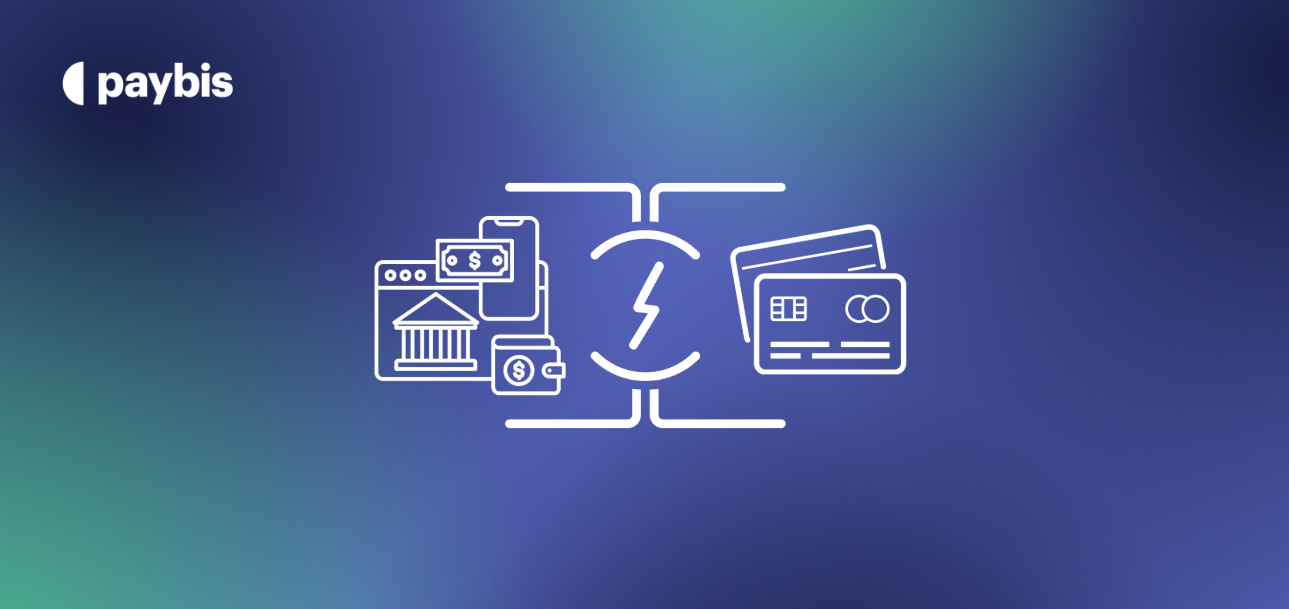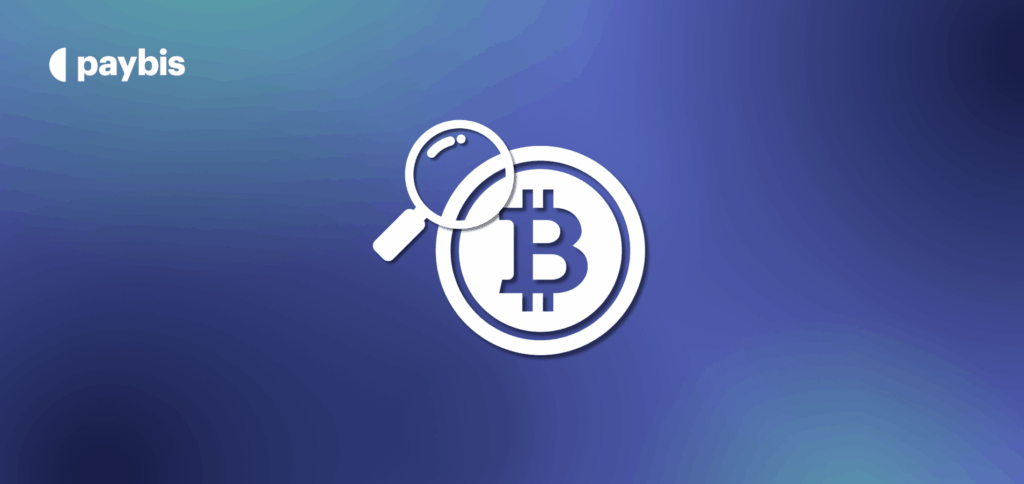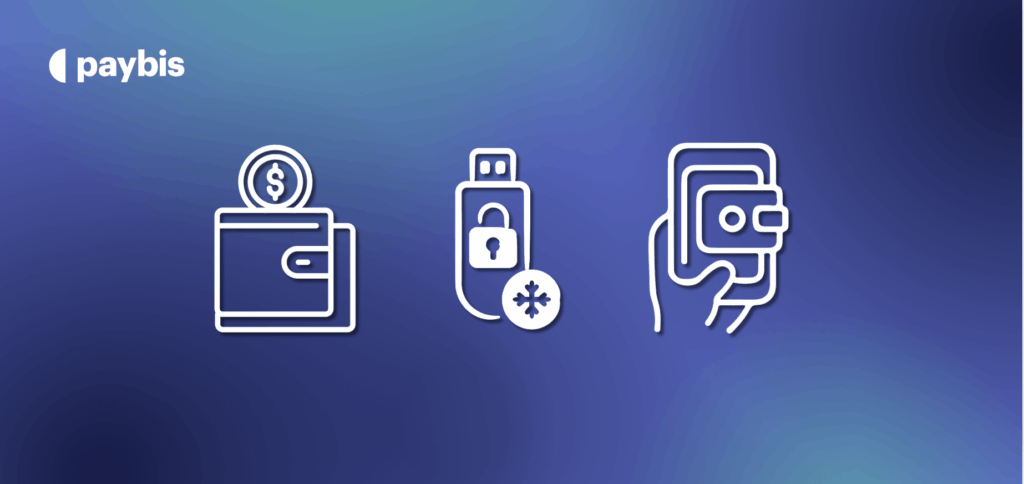APMS vs. Master Card, Credit Cards, Visa Cards for Buying Crypto
The widespread adoption of cryptocurrencies around the world is increasing. Many investors, merchants, businesses, and consumers are turning to digital assets for their flexibility and accessibility. However, as positive as this may be, the speed at which this adoption is taking place leads to several key questions, like which payment methods are the best for buying crypto.
Most popular payment methods typically include credit cards, but APMs, or alternative payment methods like PayPal, local payments, prepaid cards, or bank transfer solutions are becoming increasingly more popular.
Whether you’re a seasoned crypto trader or someone who’s just starting out with digital assets, choosing the right payment method for you can make all the difference when it comes to transaction costs, processing speed, and, of course, your own convenience.
Table of contents
- Understanding the Payment Methods & Their Differences
- What Is an Alternative Payment Method (APM)?
- List of Alternative Payment Methods
- Defining Credit Cards (Visa & Mastercard)
- Keeping Your Crypto Assets Safe: Regulatory & Bank Restrictions
- APMs vs. Credit Cards: Key Comparison Factors
- The Pros & Cons of APMs & Credit Cards
- Best Use Cases for Each Payment Method
- Future Trends in Crypto Payments
- Buying Crypto With Paybis, the Way You Want To
Understanding the Payment Methods & Their Differences
In recent years, APMs have grown considerably, making it easier for consumers and businesses to make online purchases, including cryptocurrencies. But that doesn’t mean that more traditional payment methods like credit cards don’t apply.
It all boils down to processing speeds, security, transparency, transaction fees, and more importantly, payment option availability on cryptocurrency exchanges. Most payment providers today offer similar features, but there are distinct differences that require closer consideration. However, before we jump into those, let’s first review APMs’ meaning and define credit cards.
What Is an Alternative Payment Method (APM)?
Alternative payment methods (APMs) are essentially non-traditional payment methods that allow users to transfer funds in their preferred way. APMs don’t rely on conventional card networks like Visa or Mastercard, offering more flexible and, in some cases, more cost-efficient ways to transfer money. Especially for international customers, often improving accessibility in regions where traditional banking services are limited.
List of Alternative Payment Methods
- E-wallets (PayPal, Apple Pay, Google Pay): Digital wallets that store payment details securely and allow seamless transactions. E-wallets support both fiat and crypto transactions, making it easy to buy Bitcoin with PayPal.
- Bank transfers & SEPA (ACH, SWIFT, wire transfers): Direct bank-to-bank transfers that are often used for large transactions.
- Prepaid & virtual cards (Paysafecard, Skrill, Neteller): These are reloadable or one-time-use digital or physical cards for secure transactions.
- Mobile payment apps (Venmo, Cash App): Peer-to-peer payment apps allowing instant transfers. Some apps, such as Cash App, enable crypto purchases and transfers directly within the platform.
Availability on Crypto Exchanges
Many crypto exchanges, including major platforms like Paybis, have started to integrate alternative payment methods to offer a wider selection of payment options for existing users, adapt to the changing market trends, and reach a new potential target market.
A great deal of the world’s population remains unbanked, and while crypto availability increases, the lack of traditional payment methods makes it difficult for people to acquire crypto. That’s where e-wallets, mobile wallets, and mobile wallet apps come in handy for facilitating fiat deposits and withdrawals.
In our case, Paybis started working on expanding our available payment methods in response to our users’ payment preferences. That’s why, today we offer multiple different payment options, including local payments like iDeal, MB Way, and many more.
Defining Credit Cards (Visa & Mastercard)
Credit cards are the go-to payment method for the vast majority of both online and offline payments. Even though recent trends do indicate a significant shift toward digital wallets and other alternative payment solutions, credit cards remain prominent.
In Canada, over 80% of people use credit cards as their preferred payment method and in the US, the number is at 70%. Interestingly enough, in Europe, the use of credit cards has dropped significantly, 37.7%.
Now, when it comes to using credit cards for crypto payment transactions, one survey found that in 2024 credit card usage for cryptocurrency purchases was around 33% in Italy and 32% in Canada, relatively higher than in other surveyed countries in these regions.
While alternative payment methods are indeed growing in popularity, credit cards offer unique features like the buy now pay later capability, allowing users to pay for goods using borrowed funds.
Buying Cryptos with Credit Cards
Virtually any exchange platform accepts credit cards to make instant crypto buying and selling more convenient, and also to boost customer experience as a whole. To complete a successful payment, users typically have to link to their exchange account with their card details.
Credit cards offer some of the biggest conveniences for purchasing many types of goods, including digital assets. However, typically, the fees associated with credit card purchases tend to be higher than with other payment methods due to processing costs and cash advance charges.
That aside, one of the biggest challenges with acquiring digital assets with credit cards is that some banks restrict credit card purchases of cryptocurrency due to risk concerns.
Differences Between Credit and Debit Card Usage for Crypto
- Credit cards: Allow users to buy crypto on credit, but often come with higher fees.
- Debit cards: Directly deduct funds from a linked bank account, typically with lower fees and no interest concerns.
- Risk considerations: Credit card purchases may be classified as cash advances, leading to higher fees, while debit card transactions are generally processed as standard purchases.
- Chargebacks & fraud protection: Credit cards provide stronger chargeback and fraud protection than debit cards.
Keeping Your Crypto Assets Safe: Regulatory & Bank Restrictions
Cryptocurrency regulations, or rather, policies concerning crypto purchases, differ from country to country. For example, some countries like Switzerland and Singapore adopt cryptos with clear legal frameworks, allowing banks to include crypto-related services like direct crypto buying or custody solutions. Other countries aren’t as accommodating.
As a result, people looking to buy cryptocurrency through traditional financial services like central banks have to consider national regulations and specific bank policies.
Bank Restrictions on Credit Card Crypto Transactions
Usually, banks align their policies to those of local regulations, leading to different levels of accessibility for customers. Originally, in the US, JPMorgan Chase and Bank of America allow crypto purchases but can impose restrictions on credit card transactions due to fraud and volatility concerns.
However, recent developments at the beginning of 2025 somewhat changed that sentiment, with the CEO of Bank of America, Brian Moynihan, stating that the US may embrace cryptos if the regulations allow it.
Other countries are in between stances, like India. Banks there sometimes restrict crypto transactions according to the changing regulatory policies of the Reserve Bank of India. What is agreed upon, at least in general, is that most banks roll out enhanced due diligence actions, requiring users to provide additional information before allowing crypto transactions.
It’s worth noting, though, that some countries, especially in Europe, collaborate with regulated crypto exchanges like Kraken, Binance, Coinbase, or Bitstamp to enable seamless purchases while ensuring compliance with anti-money laundering (AML) and know-your-customer (KYC) regulations.
KYC and AML Compliance for APMs vs. Credit Cards
Know Your Customer (KYC) and Anti-Money Laundering (AML) regulations are some of the main compliance policies required but differ based on the payment method used to purchase crypto. Credit card transactions normally require users to complete KYC verification (or Know Your Business KYB) through an exchange or bank to adhere to financial regulations.
On the other hand, compliance processes for alternative payment methods like prepaid cards, vouchers, and digital wallets, may have lower KYC requirements, depending on the provider of course.
However, to prevent illicit activities, APMs often have stricter transaction limits. All in all, some APMs indeed require full KYC verification, while others allow smaller transactions with minimal checks.
APMs vs. Credit Cards: Key Comparison Factors
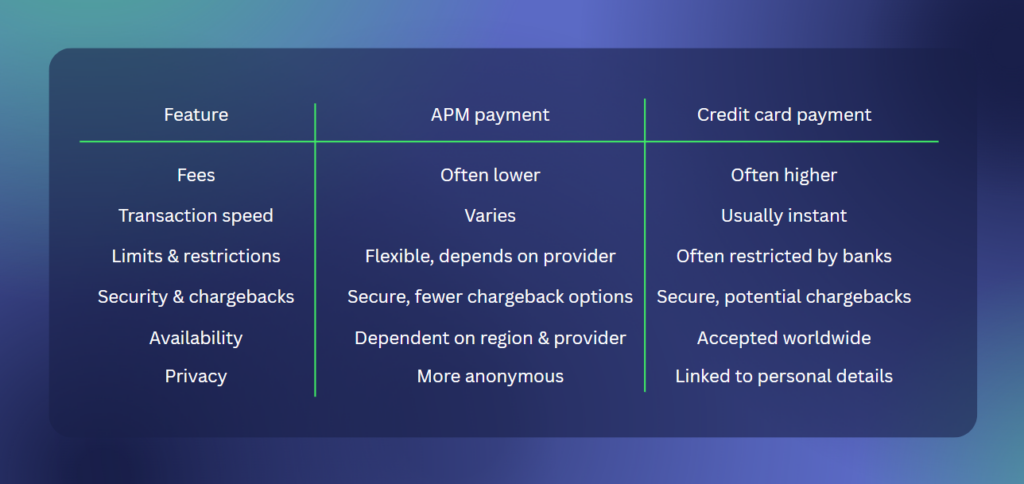
The Pros & Cons of APMs & Credit Cards
Consumer preferences, regulations, and availability aside, how do APMs and credit cards actually compare with each other? Theory is theory, but let’s go a bit deeper into the key pros and cons of each of these payment method groups.
Alternative Payment Methods (APMs)
Pros
- Lower fees: Many APMs have lower transaction costs compared to credit cards.
- Enhanced privacy: Some methods like prepaid cards and bank transfers, offer better privacy.
- No interest or cash advance fees: Unlike credit cards, APMs don’t incur high interest rates or cash advance fees.
- Bypass banking restrictions: Some APMs allow transactions even when banks restrict credit card purchases for cryptocurrency.
Cons
- Slower transactions: Certain APMs like SEPA bank transfers, can take several hours or even days to process.
- Limited exchange support: Not all crypto exchanges accept every APM.
- Weaker chargeback protections: Compared to credit cards, APMs generally offer fewer dispute resolution and fraud protection options.
Credit Cards (Visa & Mastercard)
Pros
- Instant transactions: Credit card payments are processed instantly.
- Widespread acceptance: Visa and Mastercard are accepted by most cryptocurrency exchanges.
- Rewards & cashback: Some credit cards offer cashback or rewards for purchases.
- Strong consumer protections: Credit cards provide chargeback options and fraud protection.
Cons
- Higher fees: Credit card transactions often come with cash advance fees, foreign transaction fees, and high interest rates.
- Banking restrictions: Some banks may block or limit crypto-related transactions.
- Exchange processing fees: Many exchanges charge additional processing fees for credit card payments.
Best Use Cases for Each Payment Method
When it comes to answering questions like what are the most popular payment methods, what’s the best alternative payment method, or the most popular alternative payment method, we recommend first looking at your personal needs.
Different use cases will most likely require a specific payment strategy. For example, buying fresh produce at a farmer’s market will probably require a physical cash-based payment method, and so on. Here’s a summed-up table with the most common use cases for buying cryptos.
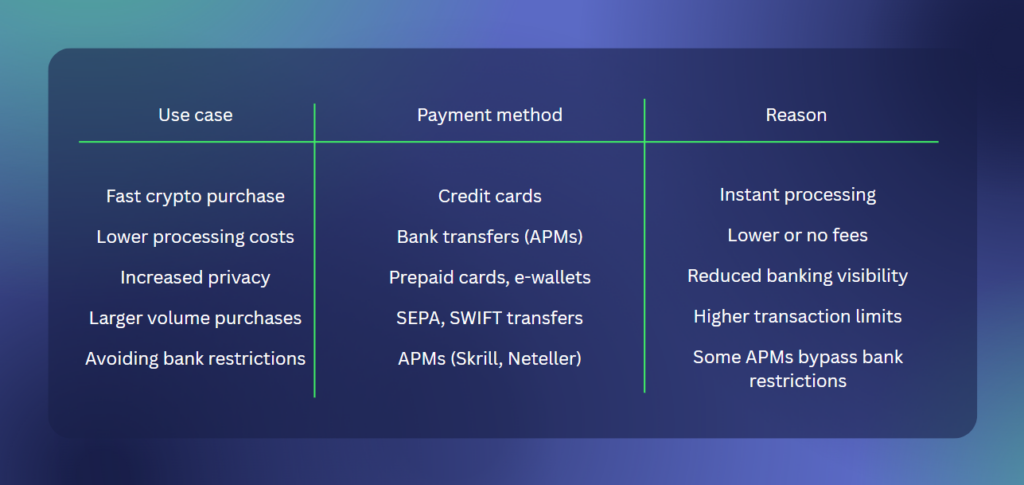
Just note that these use cases are general examples. This article is for educational purposes only.
Future Trends in Crypto Payments
The landscape of crypto payments is evolving rapidly, driven by technological advancements, increasing adoption, and regulatory shifts. Key trends shaping the future include:
- Crypto debit cards: These cards are becoming more mainstream, allowing users to spend digital assets to pay some merchants for items or services that normally accept traditional payment networks like Visa and Mastercard.
- Stablecoin payment solutions: Stablecoins are gaining traction for their low volatility compared to traditional cryptocurrencies. Merchants and payment processors are increasingly integrating stablecoin-based solutions to offer faster, borderless transactions with lower fees.
- Regulatory developments: Governments and financial regulators are exploring frameworks for stablecoins, decentralized finance (DeFi) transactions, and crypto-fiat onramps. Stricter compliance requirements could impact the ease of crypto payments, while clearer regulations may also drive institutional adoption.
Buying Crypto With Paybis, the Way You Want To
Whatever your experience may be, starting with a trusted crypto exchange platform like Paybis is the first step. Paybis is a global cryptocurrency exchange founded in 2014. It allows users to buy and sell Bitcoin, Ethereum, and other cryptocurrencies using credit/debit cards, bank transfers, and e-wallets.
We prioritize security and compliance, following strict AML/KYC procedures. With a user-friendly interface, 24/7 support, and competitive rates, Paybis is a reliable choice for both beginners and experienced traders alike.
With Paybis, you can buy Bitcoin with credit card or debit card easily and hassle-free, and let us take care of the rest!
FAQ
Is Apple Pay an APM?
Yeap, Apple Pay is an APM because it provides a digital and mobile payment solution outside of traditional credit cards and bank transfers.
What is the difference between APM and LPM?
Alternative payment methods are non-traditional payment solutions like e-wallets, cryptocurrencies, and BNPL (Buy Now, Pay Later). Local Payment Methods (LPMs) are region-specific payment solutions like iDEAL in the Netherlands or Boleto in Brazil.
Is RevolutPay and APM?
Absolutely. Revolut Pay is a popular APM for direct, fast, and secure payments without relying on traditional card networks. If you want to buy Bitcoin with RevolutPay, you can do so as it also functions as a digital wallet.
What is the difference between APM and SPM?
Application performance monitoring (APM) focuses on tracking and optimizing software performance, while strategic portfolio management (SPM) helps organizations align projects with business strategy and resource allocation. While these two may sound difficult, for anyone getting started in crypto it’s definitely enough to know the brief definitions.
Disclaimer: Don’t invest unless you’re prepared to lose all the money you invest. This is a high‑risk investment and you should not expect to be protected if something goes wrong. Take 2 mins to learn more at: https://go.payb.is/FCA-Info
